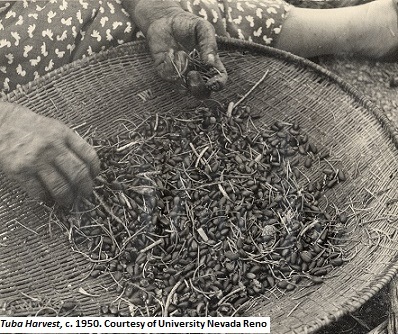Dublin Core
Title
Description
From ancient times to today, the harvest and preparation of food has been tough work, especially in the arid deserts of the Great Basin. Learn how Paiute families did that work together in order to feed and foster their communities.
Throughout Utah, families work together to make ends meet. For Paiutes living in the Great Basin, the autumn pinenut harvest has long been a critical activity that required substantial group effort. Man, woman, or child – each member of the extended family had a specific job to do during the pinenut harvest.
The pinenut season began in August with young men scouting the mountains for the most promising piñon groves. Their reports paved the way for whole families to head out when the pinenuts ripened. To harvest, young women carried cone-shaped baskets from straps across their foreheads, stooping to catch the cones and nuts as men shook them from the trees. Children scrambled between the adults to grab what fell to the ground.
As the baskets filled with nuts, girls hauled the heavy loads back to camp, where the older women sat together tending the fire and preparing the nuts for roasting. They cleaned off debris and pitch before placing the nuts into winnowing baskets under a layer of hot coals. They bounced and tossed the nuts and coals together, constantly moving and carefully watching to protect the baskets and the bounty.
When finished in the groves, the men returned to camp with the children. Those whose hands were free shared responsibility for childcare, so older men entertained children with stories and games, allowing the women to concentrate on the roasting. As the pinenuts became soft and translucent, women spread them out and cracked the shells with a grinding stone, taking care to protect the nut inside. The shelled nuts then returned to the winnowing baskets for another round of roasting. When finished, women ground the nuts into a nutritious thick paste that was a winter staple.
Paiute families shared responsibility for the pinenut harvest, a process that secured a tricky food source and strengthened their relationships. Indian families in the Great Basin still gather pinenuts today, again working together to affirm their cultural traditions.
Creator
Source
Image credit: Tuba harvest, circa 1950. The collection of pine nuts has long been a family affair for bands of Paiute people. Image courtesy University of Nevada, Reno.
_______________
See Floyd O’Neil, “The Utes, Southern Paiutes, and Gosiutes” in Helen Z. Papanikolas, ed., The Peoples of Utah, Salt Lake City: Utah State Historical Society, 1976; Forrest Cuch, ed., A History of Utah’s American Indians, Salt Lake City: Utah Division of Indian Affairs, 1996; Margaret M. Wheat, Survival Arts of the Primitive Paiutes, Reno: University of Nevada Press, 1967; William Logan Hebner, Southern Paiute: a Portrait, Logan: Utah State University Press, 2010; Paiute Tribe, Utah American Indian Digital Archive, https://utahindians.org/archives/paiute.html.

